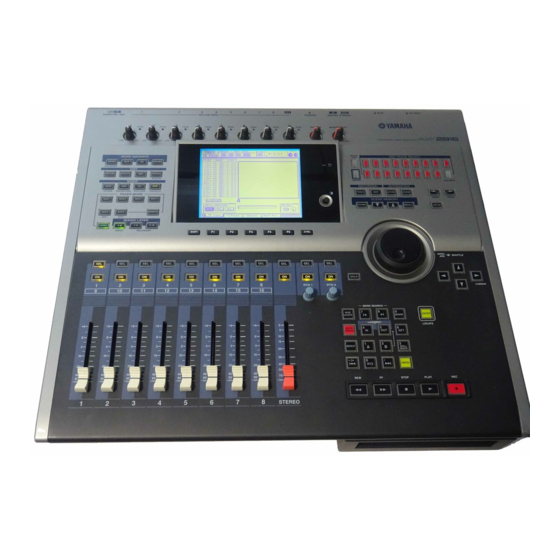Yamaha AW2816 Tutoriel - Page 29
Parcourez en ligne ou téléchargez le pdf Tutoriel pour {nom_de_la_catégorie} Yamaha AW2816. Yamaha AW2816 31 pages. Professional audio workstation, recording101
Également pour Yamaha AW2816 : Manuel d'utilisation (2 pages), Manuel de mise à jour (2 pages), Manuel (32 pages)

Glossary
Gain
A knob that adjusts the sensitivity of the head amp
(*see entry) in the input section of the AW2816. If this
control is adjusted to keep the input volumes consis-
tent at this point, it will be easier to use the faders of
each channel to create a balance.
Head amp (HA)
A circuit placed before the A/D converter (*see entry)
of an AW2816 input jack, used to adjust the analog
input signal to a level that is suitable for digital con-
version. (Also called mic preamp.)
Impedance
Resistance to alternating current. In general, this refers
to the load of a signal input or output. The input/out-
put jacks of the AW2816 have specific impedances
depending on their type or intended input/output sig-
nal, and must be connected to a device of the same or
similar impedance. Even if its cable connector has the
same form as a line input, a high-impedance source
such as a guitar must be connected to a high-imped-
ance jack, not to a regular input.
Internal arithmetic precision (bits)
The arithmetic precision with which digital signals are
processed inside a device. The AW2816 uses 32 bit
arithmetic internally, guaranteeing an excellent
dynamic range (*see entry) of 192 dB.
Jitter
When digital audio signals are transferred, the word
clock (*see entry) of the devices must match. If this
word clock is not generated accurately, a type of noise
called jitter will occur. Less variation in the word
clock rate as compared to a square wave with precise
spacing (i.e., a more stable clock) will mean less jitter
and better audio quality.
Library
Preset settings for the AW2816's equalizers (*see
entry), dynamics processors (*see entry), and the two
effect units, created with a wide range of uses in
mind.
Limiter
An effect that limits the volume to prevent overload
when the input sound exceeds a specified threshold.
Mastering
The process of adjusting the overall tone and volume
of a song that has been mixed down. On the
AW2816, the term is used in reference to the process
up to creating an audio CD.
Mini YGDAI
The YGDAI (*see entry) input/output expansion slot
found on the rear panel of the AW2816.
Mixdown
Also called "track down." The process of combining
multiple tracks of sound into a final two-track mix that
can be played back on an audio CD player, etc.
MMC (MIDI Machine Control)
A group of MIDI messages used to control recorder
operations such as Play, Stop, and Record.
28
Monitor
The headphones or speakers used to reproduce the
sound that is output from the AW2816. Also used to
refer to the act of listening to the playback from the
headphones or speakers.
Moving faders
Faders that automatically move to a position that cor-
responds to the value of the parameters that were
recalled, for example when you switch the selection
of the MIXING LAYER section or recall another scene
from scene memory. On the AW2816, all nine faders
(including the ST channel) are moving faders. This is
very convenient, since the faders will move according
to the parameter changes during automix, providing
visual confirmation of the mixdown status.
MTC (MIDI Time Code)
A type of MIDI message used to convey time data in
realtime over a MIDI cable, in order to synchronize
the operation of the AW2816 and devices such as
rhythm machines, sequencer software, or other
recorders.
Nominal level
The "nominal level" referred to on a mixer or recorder
indicates the standard level setting for that device.
When all parameters are set to the nominal level, the
audio quality will be the closest to the specifications
given in the catalog.
Optical
Refers to a type of connector to which an optical
cable is connected. For consumer audio, a format
called IEC60958 (S/P DIF) is used. However, the MY8-
AT (separately sold) option that can be installed in the
YGDAI (*see entry) slot of the AW2816 provides an
optical connector that uses the ALESIS ADAT format,
and allows eight channels of digital audio to be input
or output when connected to a compatible device.
Overdubbing
A technique that can be used on multi-track recorders
such as the AW2816, in which (for example) drums
are recorded first, and then other instruments such as
guitar and bass are recorded on other tracks while the
musician listens to the previously-recorded tracks, in
this way accumulating a larger number of tracks.
Pan
A term derived from "panorama," referring to a
parameter that specifies the location of a sound within
the stereo field. Normally if a sound that is originally
stereo is assigned to two monaural channels, the pan
controls of the two channels are set to far left and far
right so that the sound can be monitored in its original
spatial state.
Phantom power
Power that is supplied via the cable of a microphone,
and is normally required when using a condenser
mic. This is defined as 48 volts.
Pop guard
A thin mesh card placed between the vocalist's mouth
and the mic to reduce "breath" noise or "pop" noise
when recording a vocal. Tissue paper is sometimes
used.
Tutorial
